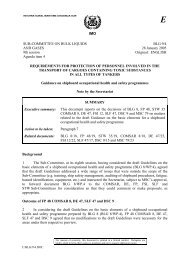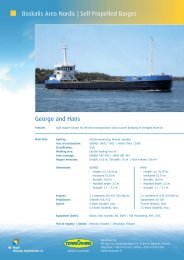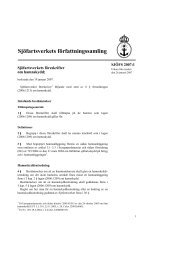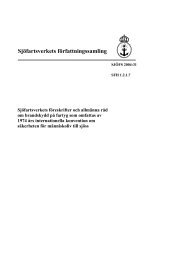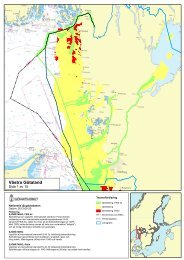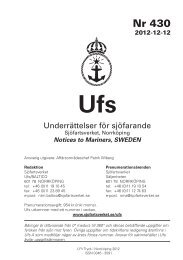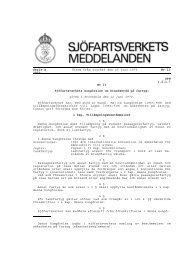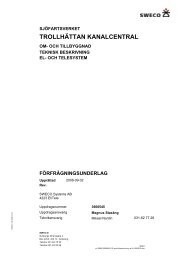AIS - Automatic Identification System
AIS - Automatic Identification System
AIS - Automatic Identification System
Create successful ePaper yourself
Turn your PDF publications into a flip-book with our unique Google optimized e-Paper software.
Silent VTS<br />
In some areas of the world e.g. rivers and low traffic areas<br />
where the traffic density don’t justify VTS, an idea called<br />
”Selent VTS” has evolved. Instead of installing conventional<br />
VTS’s on shore the <strong>AIS</strong> equipped ships will acct as their own<br />
VTS’s and use the <strong>AIS</strong> to get their situation awareness.<br />
Display presentation<br />
The <strong>AIS</strong> provides several possibilities for displaying the <strong>AIS</strong><br />
information. The minimum required display is a three line<br />
alpanumeric display that presents bearing, distance, name and<br />
all other information in a spread sheet format, enabling the<br />
OOW to make manual inputs and to identify a ship by comparing<br />
baring and range from the radar PPI. Most probably the<br />
minimum display will be very rarely used. Many ECDIS manufactures<br />
are today implementing the <strong>AIS</strong> symbols in their<br />
equipments. Manufactures, as ADVETO, STN ATLAS,<br />
TRANSAS MARINE, ANS, ICAN are already handling the<br />
<strong>AIS</strong> in their softwares.<br />
It is sometimes not possible to present the <strong>AIS</strong> information<br />
on an old radar screen but the new performance standard for<br />
radar which is developed by IMO includes presentation of <strong>AIS</strong><br />
information. <strong>AIS</strong> targets, superimposed on the radar display,<br />
will inform the operator weather the targets are <strong>AIS</strong> equipped<br />
or not.<br />
IEC has a draft proposal for <strong>AIS</strong> symbology to display on<br />
ECDIS and or ENC systems.<br />
To reduce clutter on the radar or the ECDIS display, due to<br />
too many <strong>AIS</strong>’s appearing at the same time the <strong>AIS</strong> symbols<br />
could be “Active” or “Sleeping”.<br />
● “Active” means that a triangle is showing the targets heading<br />
and (if high accurate positions used) the COG/SOG vector.<br />
● “Sleeping” means that the mariner has chosen to suppress<br />
vectors and heading line and only a small green triangle<br />
pointing in the direction of the heading is shown. A sleeping<br />
target could always be activated if the mariner selects it.<br />
High update rate<br />
A modern ARPA radar is able to select and track 20 targets<br />
with an update rate of 3 seconds. The symbol on the PPI will<br />
follow the target, except when a target swap is appearing. Due<br />
to the limitations of the ARPA, a course alteration of another<br />
ship will normally not be detected until one or two minutes<br />
after the course change. For a large tanker it will take up to five<br />
minutes. Further more, another one or two minutes is needed<br />
for the ARPA to present a reliable target vector with course and<br />
speed through the water.<br />
It is obvious that a high update rate is needed for <strong>AIS</strong> targets,<br />
superimposed on a radar display. If the update rate is too<br />
slow there will be situations, when using smaller ranges, where<br />
the <strong>AIS</strong> symbol will not catch up with the radar target.<br />
International standardisation for <strong>AIS</strong><br />
Within ITU<br />
Technical characteristics for a shipborne <strong>Automatic</strong> <strong>Identification</strong><br />
<strong>System</strong> (<strong>AIS</strong>) using TDMA in the VHF maritime<br />
mobile band has been defined by ITU in ITU-R M.1371-1<br />
Frequencies to be used for the universal shipborne <strong>AIS</strong> has<br />
been defined in ITU-R M.1084-3.<br />
Within IMO<br />
Performance standards has been defined in IMO resolution<br />
MSC.74(69) Annex 3<br />
Carriage requirements in SOLAS was originally approved by<br />
MSC 72 and MSC 73. An implementation period from 2002<br />
to 2008 was allowed. In 2001 when the security aspects of <strong>AIS</strong><br />
was highlighted, IMO decided on an accelerated implementation<br />
for ships on international voyages.<br />
<strong>Automatic</strong> identification systems (<strong>AIS</strong>)<br />
All ships of 300 gross tonnage and upwards engaged on<br />
international voyages and cargo ships of 500 gross tonnage<br />
and upwards not engaged on international voyages and<br />
passenger ships, irrespective of size, shall be fitted with <strong>AIS</strong>,<br />
as follows:<br />
1. ships constructed on or after 1 July 2002;<br />
2. ships engaged on international voyages constructed before<br />
1 July 2002;<br />
● in the case of passenger ships not later than 1 July 2003;<br />
● in the case of tankers, not later than the first Safety<br />
Equipment Survey after 1 July 2003;<br />
● in the case of ships, other than passenger ships and<br />
tankers, of 300 gross tonnage and upwards, not later<br />
than 31 Dec 2004;<br />
3. ships not engaged on international voyages constructed<br />
before 1 July 2002, not later than 1 July 2008. However, in<br />
Sweden a faster implementation is required, starting in 2003<br />
and ending 2007.<br />
4. The Administration may exempt ships from the application<br />
of the requirements of this paragraph when such ships will<br />
be taken permanently out of service within two years after<br />
the implementation date specified in paragraph 1. [Additionally,<br />
an Administration may exempt vessels flying its flag<br />
in its domestic trade from carrying <strong>AIS</strong> when operating in<br />
areas where in the judgement of the Administration the density<br />
of shipping does not justify <strong>AIS</strong>].<br />
<strong>AIS</strong> shall:<br />
● provide automatically to appropriately equipped shore<br />
stations, other ships and aircraft information, including the<br />
ship’s identity, type, position, course, speed, navigational<br />
status and other safety-related information;<br />
● receive automatically such information from similarly fitted<br />
ships;<br />
● monitor and track ships; and<br />
● exchange data with shore-based facilities. The requirements<br />
of this paragraph shall not be applied to cases where international<br />
agreements, rules or standards provide for the protection<br />
of navigational information. <strong>AIS</strong> shall be operated taking<br />
into account the guidelines adopted by the Organization.<br />
Within IEC<br />
IEC Technical Committee TC80 is now working hard to define<br />
the test standard for a simplified <strong>AIS</strong> for non SOLAS-ships.<br />
6 <strong>AIS</strong> for ships in the future




